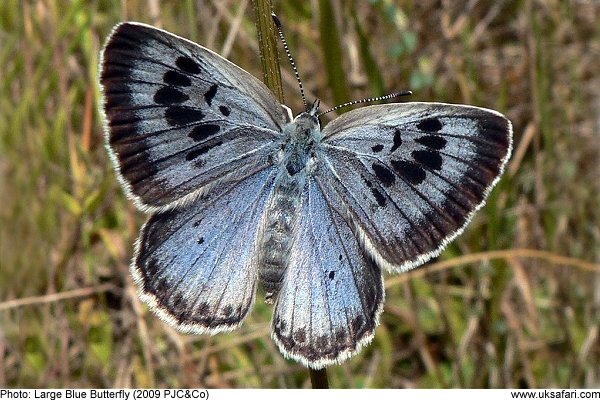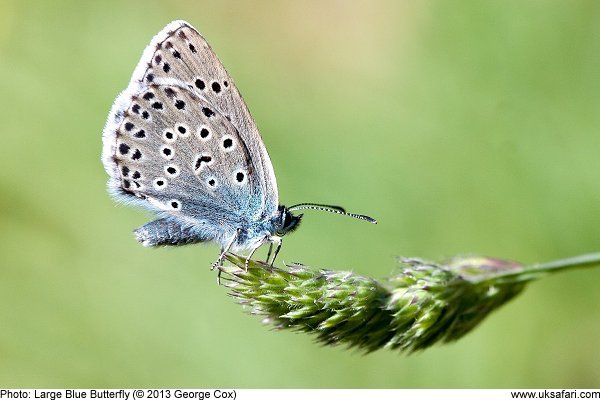 Quick Facts
Quick Facts
Scientific name: Maculinea arion
Size: Wingspan between 38mm and 52mm
Distribution: Found on a few sites in Gloucestershire, Somerset,Devon and Cornwall
Months seen: June to July
Habitat: Steep, south-facing hillsides with Wild Thyme (Thymus praecox) and ideally with nests of Myrmica sabuleti ants
Food: Nectar of Thyme and other plants. The caterpillars feed on wild Thyme flowers, Marjoram and on the grubs of Red Ants
Special features: Historical records show that the Large Blue butterfly was always a bit scarce, but in 1979 it was officially declared extinct in the UK. Large Blue Butterflies have since been reintroduced using butterflies from Sweden, and they are now established on a few sites between Gloucestershire and Cornwall.
Large Blues can be identified by the burst of black spots on the upper surfaces of the wings. No other blue butterfly has this arrangement of spots. Both the male and female are blue. The undersides of the wings feature black spots with cream coloured borders. There is no orange colouring.
Large Blue butterflies have a particularly unusual life cycle, which partly accounts for their rarity. The larval stage can only be completed inside the brood chamber of a Myrmica ant nest.
The eggs are laid on Wild Thyme, and when the caterpillars hatch they begin eating the pollen and seed. They will also eat their siblings, to reduce the competition for food and ant adoption. The tiny caterpillars have a miniscule honey-gland. This produces a sweet liquid to entice an ant to adopt it and carry it into its brood chamber. The ant believing it to be a misplaced grub from its own nest. Once inside the brood chamber the caterpillar begins feeding on the ant grubs.
Following pupation the adult Large Blue Butterfly hatches from its pupal case and emerges from the nest the following June. Once above ground it climbs a plant stem to inflate its wings. The adult butterflies live for around five days.
 Related Pages
Related Pages

 Popular Pages
Popular Pages
Amphibians, Bats, Badgers, Beetles, Birds, Birds of Prey, Bumble Bees, Butterflies, Caterpillars, Creepy-Crawlies, Deadly Spiders, Dolphins, Dragonflies, E-Postcards, False Widow Spiders, Free Newsletter, Frogs, Fungi, Garden Spiders, Glow-Worms, Grey Squirrels, Hedgehogs, House Spiders, Ladybirds, Mammals, Marine Mammals, Moths, Owls, Reptiles, Spiders, Toads, Trees, Wildlife Hospitals
© Copyright 2017 G. Bradley - UK Safari | About Us | Links | Contributors


 Large Blue Butterflies
Large Blue Butterflies



